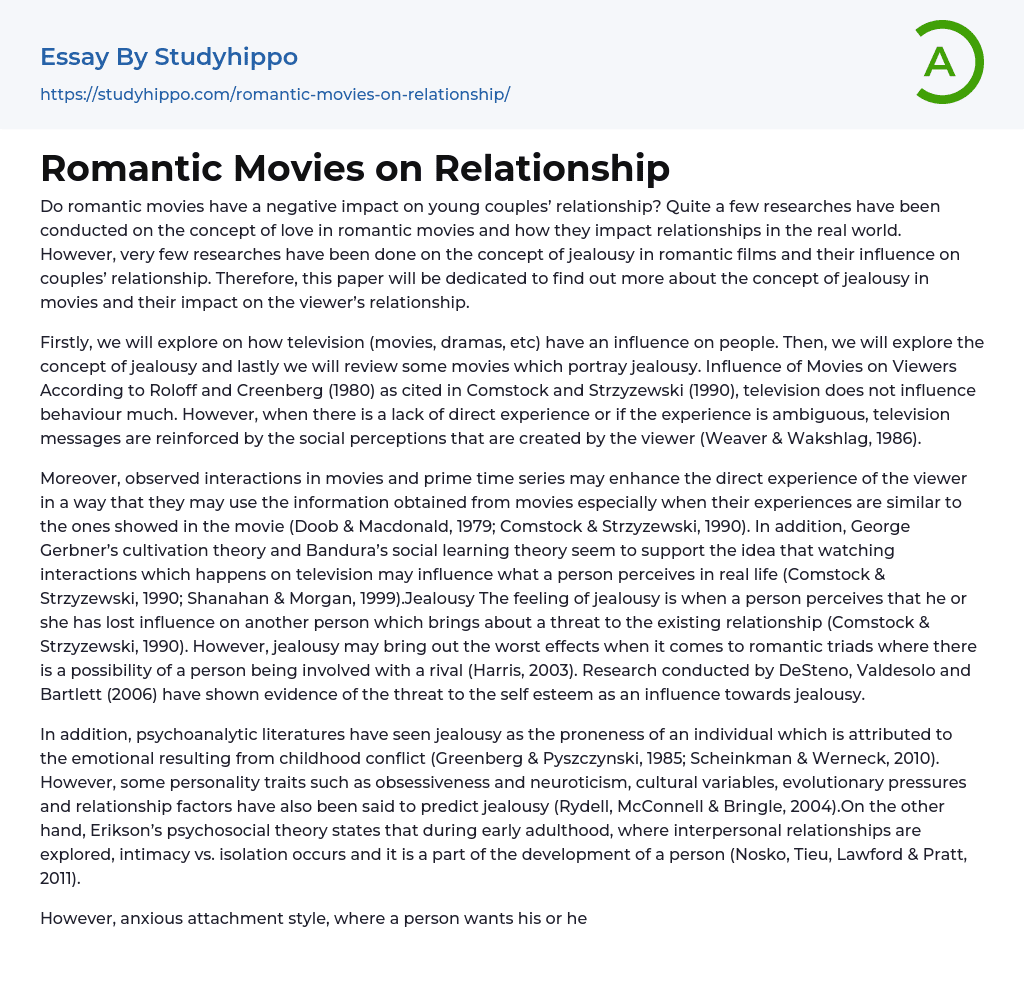While studies have examined the influence of romantic movies on the love lives of young couples, there has been scant attention paid to how jealousy is portrayed and its implications for real relationships. This paper aims to investigate this subject matter and its impact on viewers' relationship dynamics.
The impact of television, including movies and dramas, on people and the portrayal of jealousy in movies will be discussed in this text. While Comstock and Strzyzewski (1990) argue that television does not have a significant effect on behavior, Roloff and Creenberg (1980) suggest that if direct experience is lacking or confusing, social perceptions of the viewer may strengthen the messages conveyed through television. Weaver ; Wakshlag (1986) support this perspective.
Furthermore, it is possible that watching interactions in movies and prime time series could enhance the viewer's direct experience, particularly if they have had similar ex
...periences portrayed in the film (Doob & Macdonald, 1979; Comstock & Strzyzewski, 1990), supported by George Gerbner's cultivation theory and Bandura's social learning theory (Comstock & Strzyzewski, 1990; Shanahan & Morgan, 1999). The feeling of jealousy arises when someone perceives that they have lost influence over another person, which poses a threat to the existing relationship (Comstock & Strzyzewski, 1990). However, romantic triads present a greater risk for negative effects caused by jealousy, especially when one person becomes involved with a rival (Harris, 2003). Research conducted by DeSteno, Valdesolo and Bartlett (2006) has shown that the threat to self-esteem can influence the intensity of jealousy.
Jealousy has been studied in various psychoanalytic literatures, which attribute its presence to emotional disturbances resulting from childhood conflicts (Greenberg & Pyszczynski, 1985; Scheinkman & Werneck, 2010)
However, other factors such as personality traits - like obsessiveness and neuroticism -, cultural variables, evolutionary pressures, and relationship factors have also been identified as predictors of jealousy (Rydell, McConnell & Bringle, 2004). Furthermore, Erikson's psychosocial theory suggests that during early adulthood, when individuals explore interpersonal relationships, the developmental stage of intimacy vs. isolation occurs (Nosko, Tieu, Lawford ; Pratt, 2011).
Despite the potential for anxious attachment style, which may lead to increased jealousy and insecurity in relationships (Collins, Cooper, Albino ; Allard, 2002; Nosko et al. 2011), there is a lack of research specifically on jealousy portrayal in television. One study conducted by Comstock and Strzyzewski (1990) videotaped 29 hours of prime time television programmes in 1987 to 1988 and found that jealousy was portrayed in 48.9% of instances. Their analysis showed that romantic involvement with a rival posed the biggest threat for a jealous individual (Comstock ; Strzyzewski, 1990). Another study by Rydell et al. is mentioned but not further explained.
According to a study conducted in 2004, the presence of a threat can induce jealousy in individuals who may experience it more intensely when negative information is received regarding their compatibility in a high commitment relationship. Additionally, research cited in Barelds and Barelds-Dijkstra (2007) reveals three forms of jealousy which include reactive, possessive, and anxious jealousy. Reactive jealousy involves a higher emotional component when a person experiences negative feelings due to a partner being unfaithful either emotionally or sexually. Possessive jealousy involves behavioral control where an individual restricts their partner's contact with the opposite gender. In contrast, anxious jealousy involves cognitive aspects such as rumination, distrust, worry, anxiety, and suspicion. The study found
that anxious jealousy has a negative correlation with relationship quality while reactive jealousy has a positive correlation (Barelds & Barelds-Dijkstra, 2007). Furthermore, this article explores how movies can influence real-life relationships and the concept of jealousy.
This section discusses jealousy in romantic movies, which often appears in the form of a rival threatening a relationship. In When a Man Loves a Woman (1994), Michael became jealous when Alice's guy-friend wanted to talk to her in private and she happily spent time with him. In Valentine's Day (2010), Jason was annoyed when he caught Liz having phone sex with another man. Similarly, in Beauty and the Briefcase (2010), Tom was jealous of Lane dating everyone in the office except him and doubted her article about Seth and their sexual exploits. These films may negatively affect young couples by making them suspicious about their own relationships.
- Pressure essays
- Confidence essays
- Disgrace essays
- Lost essays
- Harmony essays
- Fairness essays
- Sarcasm essays
- Respect essays
- Responsibility essays
- Empathy essays
- Suffering essays
- Suspense essays
- Fear essays
- Feeling essays
- Loneliness essays
- Ambition essays
- Tolerance essays
- Hope essays
- Inspiration essays
- Kindness essays
- Shame essays
- Desire essays
- Doubt essays
- Grief essays
- Hate essays
- Laughter essays
- Passion essays
- Pride essays
- Forgiveness essays
- Happiness essays
- Humanity essays
- Loyalty essays
- Guilt essays
- Honesty essays
- Betrayal essays
- Need essays
- Boredom essays
- Courage essays
- Regret essays
- Anger essays
- Honor essays
- Honesty Is The Best Policy essays
- Wall Street essays
- Dead Poets Society essays
- A beautiful mind essays
- Sherlock Holmes essays
- Our day out essays
- American Beauty essays
- Do The Right Thing essays
- Forrest Gump essays




